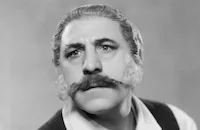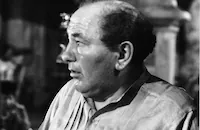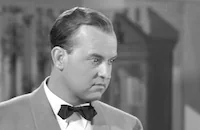A Bell for Adano

Brief Synopsis
Cast & Crew
Henry King
Gene Tierney
John Hodiak
William Bendix
Glenn Langan
Richard Conte
Film Details
Technical Specs

Synopsis
In the waning days of World War II, Major Joppolo, an American of Italian descent, arrives in the small Sicilian town of Adano to take control of the local government which has been in disarray ever since its mayor and other Fascist government officials fled. Joppolo finds the town ravaged by war, its populace of women and old men demoralized by deprivation and the corruption of their Fascist oppressors. Surrounded by remnants of the vanquished Fascist regime, Zoppolo is greeted by Zito and Giuseppe, two of the townsmen who eagerly offer their services. Questioned by Joppolo about what their town needs most, the men lament the loss of their beloved church bell, a loss that overwhelms their hunger and other hardships. After Father Pensovecchio explains that the peals of the bell regulated the daily rhythms of life in the village, Joppolo asks the priest's help in convincing his flock to accept the new American rule. Wary of life under a conquering government, the priest tests Joppolo's sincerity by inviting him to Mass. When the major fulfills his commitment by appearing at the church, he earns the priest's confidence. Later, the major wins the respect of the townspeople when he mandates that government officials will have no special privileges in the bread lines. To secure food for the village, Joppolo asks to see Tomasino, the town's stubborn fishing chief, who has renounced his trade. When Tomasino refuses to come to headquarters, Joppolo goes to his fishing boat, trailed by the women of the village. Suspicious of authority, Tomasino is certain that Joppolo intends to impose a tax on his catch until the major convinces him he only wants to feed the people of Adano. With the help of Lt. Livingstone, a naval officer, Tomasino and his fleet are soon trolling the waters once more. In gratitude, the fishermen send Tina, Tomasino's attractive blonde daughter, to invite Joppolo to dinner. The major, meanwhile, has discovered that the town bell has been melted down. He offers to replace it with a Liberty bell, but the townspeople reject the idea of a cracked bell. When General McKay, Joppolo's commanding officer, orders the main road to Adano to be cleared of all mule carts and other civilian vehicles to make room for military convoys, the villagers dolefully gather outside the major's office to plead that they will perish unless they are allowed to transport food and water into town. Touched by their plight, the major countermands the order over the objections of Capt. Purvis, one of the officers under his command. When Purvis decides to report Joppolo's insubordination to Col. Middleton, the Provost Marshall, Joppolo's sympathetic assistant, Sgt. Borth, stashes the report under a stack of papers on Purvis' desk. That night at Tomasino's house, Tina confides to Joppolo that she dyed her hair blonde to be different, and he tells her about life in the Bronx and mentions that he has a wife. Soon after, Purvis answers the phone at headquarters and is chastised by Middleton for not promptly sending his reports. When Purvis discovers that the letter regarding Joppolo's insubordination is still sitting on his desk, he orders it to be sent immediately, but Borth sabotages the delivery by addressing it to Algiers. After Joppolo's request for a replacement bell is denied, the major turns to Lt. Livingstone. Livingstone's friend, Commander Robertson, recalls a bell on a destroyer commanded by an old shipmate and promises to help. Late one night, a lonely Joppolo visits Tina and she asks him to find out about the status of her soldier sweetheart, Giorgio. Sensing that the major has fallen in love with her, Tina suggests that his desire for her is fueled by his longing for his wife. Soon after, the town's young men return from war and are eagerly welcomed by the women. Giorgio is not among them, however, and Joppolo comforts the grieving Tina as Giorgio's friend, Nicolo, recounts how Giorgio met his death while trying to rally a mob of drunken, disillusioned soldiers. Just as Middleton finally receives the misdirected letter, Robertson delivers to Adano an impressive new bell found in the waters off the African coast. As the town rejoices, a cable arrives from Middleton, notifying Joppolo that he has been relieved of duty for insubordination and must immediately report to Algiers. Opening the cable, Borth decides to withhold the news from Joppolo until after the party to be held that night in his honor. Later, in his office, the villagers unveil a portrait of Joppolo, and after they leave, the major studies the painting, speechless. His reverie is interrupted by the drunken Borth, who blurts out that the major has been relieved of duty and then bursts into tears. Joppolo finds solace in a final dance with Tina, and the next morning, as the bell tolls for the first time, he leaves town, unable to bid farewell to his friends.

Director
Henry King
Cast

Gene Tierney

John Hodiak

William Bendix
Glenn Langan

Richard Conte
Stanley Prager

Henry Morgan
Montague Banks
Reed Hadley

Roy Roberts

Hugo Haas

Marcel Dalio

Fortunio Bonanova

Henry Armetta

Roman Bohnen
Luis Alberni

Eduardo Ciannelli
William Edmunds
Yvonne Vautrot
John Russell
Anna Demetrio

James Rennie
Charles La Torre

Charles Judels
Frank Jaquet
Gino Corrado
Peter Cusanelli

Minor Watson

Grady Sutton
Joseph "chef" Milani
Hector V. Sarno
Teresa Tirelli
Annina Verrone
Inez Palange
Mimi Aguglia
Carmen Castellano
Valeria Caravacci
Elvira Curci
Rita Nardi
Minerva Urecal
Nick Thompson
Antonio Filauri
Alexander Sacha
Rudy Rama
Marie Monteil
Shirley Karnes
Helen Ciancaglini
Lola Pardinas
Zedra Conde
Gilda Oliva
Frank Lackteen
Ed Mundy
Nino Pipitone Jr.
Joseph Burlando
Julian Rivero
Earl Easton
Mario Pirrone
David Cota
Franco Corsaro
Francis Ravel
Jerry Riggio
Attilio Barbato
John Bagni
Serge Krizman
Ted Jordan
Guy Pharis
Dino Bolognese
Ray Barons
Dave Ballard
Russell Hoyt
Robert B. Castaine
Harry Carter
Edward Hyans
Eva Puig
Crew
Lloyd Ahern
Joseph Behm
Serge Bertensson
Col. Phillip W. Booker
W. D. Flick
Ralph O. Hammeras
Roger Heman
Frank E. Hughes
Mark-lee Kirk
R. A. Klune
Joseph La Shelle
Louis D. Lighton
Thomas Little
Barbara Mclean
Alfred Newman
Ben Nye
Major John L. Porter Jr., U.s. First Armored Divison
Edward Powell
Norman Reilly Raine
Frances C. Richardson
Captain Morton T. Seligman U.s.n. Ret.
Fred Sersen
Murray Spivack
Nick S. Trani
Lamar Trotti
Lamar Trotti
Helen Webb
Lyle Wheeler
Colonel Wilson C. Williams U.s. Army Service Forces
Yvonne Wood

Film Details
Technical Specs

Articles
A Bell for Adano -
The story concerns Italian-American U.S. Army Major Victor Joppolo, placed in charge of the town of Adano during the campaign in Sicily, and his efforts to replace the 700-year-old bell that was taken from the town by the Fascists to be melted down for ammunition. In Hersey's book, Joppolo also tries to alleviate the hardships placed on the townspeople by his hard-nosed, dictatorial commanding officer. Under the purchase agreement with Fox, Hersey was given 90 days to get War Department approval for his story to be adapted to the screen. Officials were worried the film would carry over the novel's unflattering portrait of the unlikable general, so Hersey failed to meet his deadline. The studio intervened, changing the story enough to get clearance. According to an article in the New York Times, the War Department was pleased to find that "the inconveniences suffered by the townspeople in the film were presented as the natural consequences of war, and not the result of any one person."
That wasn't the end of the trouble, however. Hersey based his novel on the real-life experiences of Frank Toscani, the military governor of the Sicilian town of Licata, which became Adano in the book. War reporter Hersey had visited him in Licata for several days and learned of Toscani's replacement of the bell. There was one detail the author created for his fictional account, however, that didn't sit well with the married officer--an affair with a beautiful Italian woman. In February 1946, Toscani sued Fox, Hersey, and Hersey's publisher, Alfred A. Knopf, for $225,000, along with producer Leland Hayward and playwright Paul Osborn, who were responsible for a Broadway version of the novel. The suit claimed irreparable damage to Toscani's reputation, not only from the romantic affair but because he was shown countermanding orders from his superior. In November 1946, an appellate course dismissed the suit on the grounds that the law was not "intended to give a living person cause...for damages based on the mere portrayal of acts and events concerning a person designated fictitiously in a novel or play."
According to the Hollywood Reporter around the time of preproduction, the studio had considered actors as widely divergent as Dana Andrews, Gary Cooper, and James Cagney for the lead. They settled instead on John Hodiak, who had not as yet been the lead in a major motion picture, although he had received good notices for his work in Alfred Hitchcock's Lifeboat (1944). Following that, he played another soldier in a warm homefront drama, Sunday Dinner for a Soldier (1944), opposite his soon-to-be wife, Anne Baxter. Hodiak proved to be a good choice for the role of Joppolo, earning praise from New York Times critic Bosley Crowther as "excellent...firm and unquestionably sincere, with just the right shades of emotion in his responses to human problems."
Top billing went to Gene Tierney, whose career had just been given a major boost as the title character in the superb thriller Laura (1944). Despite her miscasting as a blonde Sicilian, Tierney's career ascent continued with A Bell for Adano. Just six months later, she gave her best performance in the twisted thriller Leave Her to Heaven (1945), for which she received her only Academy Award nomination.
The film was produced between late November 1944 and early January 1945, with location work at Brent's Crag, Calif. Its director was Henry King, who would establish a long reputation for successfully bringing popular novels and true stories to the screen, among them Stanley and Livingstone (1939), The Song of Bernadette (1943), Wilson (1944), Hemingway's The Sun Also Rises (1957), and Fitzgerald's Tender Is the Night (1962).
In addition to the Broadway play, which starred Fredric March, there have been several other versions of the story. In a 1955 Lux Video Theatre adaptation, Edmond O'Brien had the lead, with a young Charles Bronson playing the part William Bendix took in the movie. Barry Sullivan and Anna Maria Alberghetti were in a 1956 CBS telecast, and John Forsythe played the major in a 1967 Hallmark Hall of Fame broadcast.
The cast contains, in a small role as Zito, one of the villagers, the Paris-born actor Marcel Dalio, once a major player in French cinema (La Grande Illusion, 1937; Rules of the Game, 1939). A Jew, Dalio fled France during the war and played supporting roles in such Hollywood films as Casablanca (1942), The Song of Bernadette (1943), and To Have and Have Not (1944). He returned to France after the war and worked steadily all over the world, including on American TV, until shortly before his death in 1983.
Director: Henry King
Producers: Louis D. Lighton, Lamar Trotti
Screenplay: Lamar Trotti, Norman Reilly Raine, based on the novel by John Hersey
Cinematography: Joseph LaShelle
Editing: Barbara McLean
Original Music: Alfred Newman
Art Direction: Mark-Lee Kirk, Lyle Wheeler
Cast: Gene Tierney (Tina Tomasino), John Hodiak (Major Joppolo), William Bendix (Sgt. Borth), Glenn Langan (Lt. Livingstone), Richard Conte (Nicolo)
By Rob Nixon

A Bell for Adano -
Quotes
Trivia
Notes
The film's title card reads "John Hersey's A Bell for Adano." In onscreen credits, Eduardo Ciannelli's name as misspelled as "Edwardo." According to materials contained in the Twentieth Century-Fox Records of the Legal Department, located at the UCLA Arts-Special Collections Library, Fox paid Hersey $85,000 for the motion pictures rights to his novel. The studio also guaranteed a bonus of twenty cents per copy sold, with the total bonus not to exceed $15,000. Under the agreement, Hersey was given ninety days to obtain approval from the War Department to incorporate into the film the plot, theme episodes and characters contained in his novel. Hersey failed to meet his deadline, however, and the studio then obtained its own clearances. According to a July 1944 New York Times news item, the War Department was concerned that the film would adhere to the novel's unflattering portrayal of "General McKay," in which the officer's dictatorial behavior caused the villager's woes. The War Department was relieved when "the inconveniences suffered by the townspeople in the film were presented as the natural consequences of war, and not the result of any one person."
Materials in the legal records disclose that the character of "Major Joppolo" was based on Lt. Col. Frank E. Toscani, who served as the senior civil affairs officer of the American military government in Licata, Italy. In February 1946, Toscani sued Fox, Hersey and Hersey's publisher, Alfred A. Knopf, theatrical producer Leland Hayward and playwright Paul Osborn (who produced and wrote a Broadway play based on Hersey's novel), for $225,000, charging that he had been "damaged by being portrayed as Major Joppolo." Toscani claimed that the novel "recklessly, maliciously and falsely states certain defamatory matters. In particular, Toscani, a married man, objected to Joppolo's love affair and to the fact that the officer was shown countermanding an order from a superior. In November 1946, an appellate course dismissed the suit on the grounds that the law was not "intended to give a living person cause...for damages based on the mere portrayal of acts and events concerning a person designated fictiously in a novel or play."
Hollywood Reporter news items yield the following information about the production: Dana Andrews, Gary Cooper and James Cagney were all considered for the role of Joppolo. A July 1944 New York Times news item adds that Spencer Tracy was also considered for the role. John Hodiak was finally borrowed from M-G-M to star as the major. According to a June 1947 article in Saturday Evening Post, Joppolo was Hodiak's favorite role. Although an October 1944 item states that Estelle Taylor was to be tested for a part, she was not in the released film. A November 3, 1944 Hollywood Reporter production chart also places Allyn Joslyn in the cast, but he did not appear in the released film. According to materials in the legal files, Eula Morgan was originally cast as "Rosa." For their outstanding work during the mob scene, Minerva Urecal, Mimi Aguglia, Elvira Curci, Nick Thompson, Antonio Filauri, Valeria Caravacci and Carmen Castellano were awarded larger roles in the film, according to a November 1944 news item. An October 1944 item adds that location filming was done at Brent's Crags, CA.
Hersey's novel was also the basis for Paul Osborn's 1945 Broadway play A Bell for Adano, starring Fredric March. On June 2, 1956, CBS broadcast a televised version of Hersey's story, starring Barry Sullivan and Anna Maria Alberghetti and directed by Paul Nickell, and on November 15, 1967, The Hallmark Hall of Fame broadcast a version starring John Forsythe and Murray Hamilton and directed by Mel Ferrer.














